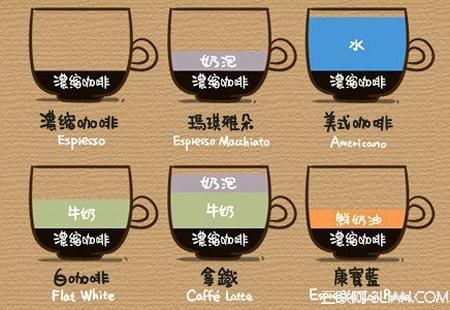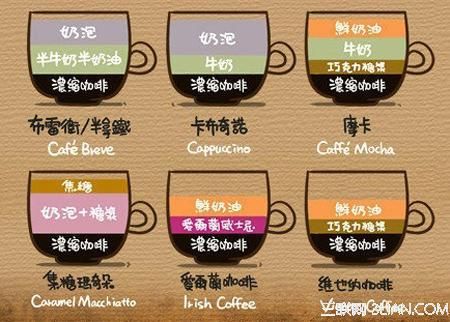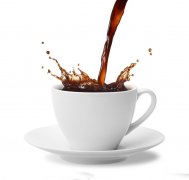Introduction to the types of Coffee basic knowledge of Italian Coffee
I hear a lot about coffee, but do you know the names of all kinds of coffee easily? What are the common types of coffee, what are its practices and ingredients? A few days ago, a website organized and drawn such a lovely picture to let you know the composition of coffee at a glance. You will know after reading this article. The next time you go to a cafe, you don't have to ask people what you should drink.

Espresso (Espresso), originally in Italian, means "make it for you right away". It is commonly known as Italian espresso. Espresso is the use of high pressure, so that boiling water quickly through the coffee powder in just a few seconds, to get about 1 ounce of coffee, bitter and fragrant.
Macchiato (Espresso Macchiato). The original text of Macchiato is Italian, which stands for "imprint, imprint". It is pronounced "Macchiato", but we are used to calling it Macchiato. Macchiato is to add a thin layer of hot milk foam to the espresso to keep the coffee warm. The delicate and sweet milk foam can cushion the bitter impact of espresso. If you want to drink coffee but can't give up the sweetness, you can choose macchiato.
American coffee (Americano). Black coffee is made using instruments such as drip coffee pots, siphon pots, French presses, etc., or a large amount of water is added to Italian espresso. The taste is light, but because of the long extraction time, the caffeine content is high.
White coffee (Flat White). Malaysian native products have a history of more than 100 years. White coffee does not mean that the color of coffee is white, but uses special coffee beans and special skimmed cream raw materials, after special processing of coffee, glycol aroma does not hurt the intestines and stomach, retaining the original color and flavor of coffee, the color is lighter and softer than ordinary coffee, so it is named white coffee.
Latte (caf è Latte). The latte is as simple as pouring nearly boiling milk into a freshly made espresso. In fact, there is no fixed rule on how much milk is added, and it can be freely mixed according to individual taste.
Campbell Blue (Espresso Con Panna). In Italian, Con means stirring, Panna is whipped cream, and Campbell blue means espresso with whipped cream. There is a saying that the authentic Campbell Blue should be served with a chocolate or toffee, first put the chocolate or toffee in your mouth, and then drink coffee to let the delicacy bloom in your mouth.

Brewer / half latte (Cafe Breve). Much like a latte, the difference is that it is not milk, but a mixture of half-milk and half-cream, sometimes with a little foam.
Cappuccino (Cappuccino). The traditional cappuccino is 1/3 espresso, 1/3 steamed milk and 1/3 foamed milk. Cappuccinos are divided into dry and wet ones. Dry cappuccino (Dry Cappuccino) refers to the conditioning method with more milk bubbles and less milk, and the coffee tastes stronger than milk flavor. Wet cappuccino (Wet Cappuccino) refers to the practice of fewer milk bubbles and more milk, with the smell of milk overshadowed by the thick smell of coffee, which is suitable for those with light taste.
Caff è Mocha. One of the oldest coffee, named after the famous port of Mocha. Mocha is a mixture of Italian espresso, chocolate syrup, whipped cream and milk. It is a variant of Italian latte.
Caramel macchiato (Caramel Macchiato). Macchiato with caramel is a drink made by adding espresso and vanilla to strong hot milk and finally sprinkled with pure caramel. it is characterized by three different flavors in one drink.
Irish coffee (Irish Coffee). A kind of coffee that looks like both wine and coffee is made by mixing hot coffee, Irish Whiskey, cream and sugar.
Viennese coffee (Viennese Coffee). Austria's most famous coffee, sprinkle a thin layer of sugar or rock sugar on the bottom of a warm coffee cup, then pour hot and thick black coffee into the cup, and finally decorate the coffee surface with two tablespoons of cold fresh cream. A cup of Viennese coffee is ready.
Important Notice :
前街咖啡 FrontStreet Coffee has moved to new addredd:
FrontStreet Coffee Address: 315,Donghua East Road,GuangZhou
Tel:020 38364473
- Prev

The Origin of Coffee Coffee is mainly produced in countries and etiquette
The origin of coffee the word coffee comes from the Greek word Kaweh, meaning strength and enthusiasm. Coffee tree is an evergreen shrub of Capsaceae. Daily coffee is made from coffee beans combined with a variety of cooking utensils, and coffee beans refer to the nuts in the fruit of coffee trees, which are then roasted with appropriate roasting methods. There are various legends about the origin of coffee, but most of them
- Next

Coffee related skills the use of coffee cups and saucers
How to add sugar to coffee? when adding sugar to coffee, sugar can be scooped out with a coffee spoon and added directly to the cup; or you can first use a sugar clip to clip the cube sugar on the near side of the coffee plate, and then use a coffee spoon to add the cube sugar to the cup. If you put the cube sugar directly into the cup with a sugar clip or hand, it may sometimes spill the coffee and stain the clothes or tablecloth. How to use coffee spoons? coffee spoons are special.
Related
- Beginners will see the "Coffee pull flower" guide!
- What is the difference between ice blog purified milk and ordinary milk coffee?
- Why is the Philippines the largest producer of crops in Liberia?
- For coffee extraction, should the fine powder be retained?
- How does extracted espresso fill pressed powder? How much strength does it take to press the powder?
- How to make jasmine cold extract coffee? Is the jasmine + latte good?
- Will this little toy really make the coffee taste better? How does Lily Drip affect coffee extraction?
- Will the action of slapping the filter cup also affect coffee extraction?
- What's the difference between powder-to-water ratio and powder-to-liquid ratio?
- What is the Ethiopian local species? What does it have to do with Heirloom native species?

